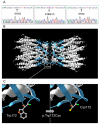Unique Mutational Spectrum of the GJB2 Gene and its Pathogenic Contribution to Deafness in Tuvinians (Southern Siberia, Russia): A High Prevalence of Rare Variant c.516G>C (p.Trp172Cys)
- PMID: 31195736
- PMCID: PMC6627114
- DOI: 10.3390/genes10060429
Unique Mutational Spectrum of the GJB2 Gene and its Pathogenic Contribution to Deafness in Tuvinians (Southern Siberia, Russia): A High Prevalence of Rare Variant c.516G>C (p.Trp172Cys)
Abstract
Mutations in the GJB2 gene are the main cause for nonsyndromic autosomal recessive deafness 1A (DFNB1A) in many populations. GJB2 mutational spectrum and pathogenic contribution are widely varying in different populations. Significant efforts have been made worldwide to define DFNB1A molecular epidemiology, but this issue still remains open for some populations. The main aim of study is to estimate the DFNB1A prevalence and GJB2 mutational spectrum in Tuvinians-an indigenous population of the Tyva Republic (Southern Siberia, Russia). Sanger sequencing was applied to analysis of coding (exon 2) and non-coding regions of GJB2 in a cohort of Tuvinian patients with hearing impairments (n = 220) and ethnically matched controls (n = 157). Diagnosis of DFNB1A was established for 22.3% patients (28.8% of familial vs 18.6% of sporadic cases). Our results support that patients with monoallelic GJB2 mutations (8.2%) are coincidental carriers. Recessive mutations p.Trp172Cys, c.-23+1G>A, c.235delC, c.299_300delAT, p.Val37Ile and several benign variants were found in examined patients. A striking finding was a high prevalence of rare variant p.Trp172Cys (c.516G>C) in Tuvinians accounting for 62.9% of all mutant GJB2 alleles and a carrier frequency of 3.8% in controls. All obtained data provide important targeted information for genetic counseling of affected Tuvinian families and enrich current information on variability of GJB2 worldwide.
Keywords: GJB2; Russia; Southern Siberia; Tuvinians; hearing loss; nonsyndromic autosomal recessive deafness 1A (DFNB1A).
Conflict of interest statement
The authors declare no conflict of interest.
Figures


Similar articles
-
High Rates of Three Common GJB2 Mutations c.516G>C, c.-23+1G>A, c.235delC in Deaf Patients from Southern Siberia Are Due to the Founder Effect.Genes (Basel). 2020 Jul 21;11(7):833. doi: 10.3390/genes11070833. Genes (Basel). 2020. PMID: 32708339 Free PMC article.
-
Functional Evaluation of a Rare Variant c.516G>C (p.Trp172Cys) in the GJB2 (Connexin 26) Gene Associated with Nonsyndromic Hearing Loss.Biomolecules. 2021 Jan 5;11(1):61. doi: 10.3390/biom11010061. Biomolecules. 2021. PMID: 33466560 Free PMC article.
-
Autosomal recessive deafness 1A (DFNB1A) in Yakut population isolate in Eastern Siberia: extensive accumulation of the splice site mutation IVS1+1G>A in GJB2 gene as a result of founder effect.J Hum Genet. 2011 Sep;56(9):631-9. doi: 10.1038/jhg.2011.72. Epub 2011 Jul 21. J Hum Genet. 2011. PMID: 21776002
-
Update of spectrum c.35delG and c.-23+1G>A mutations on the GJB2 gene in individuals with autosomal recessive nonsyndromic hearing loss.Ann Hum Genet. 2019 Jan;83(1):1-10. doi: 10.1111/ahg.12284. Epub 2018 Sep 3. Ann Hum Genet. 2019. PMID: 30175840 Review.
-
Functional Consequences of Pathogenic Variants of the GJB2 Gene (Cx26) Localized in Different Cx26 Domains.Biomolecules. 2023 Oct 13;13(10):1521. doi: 10.3390/biom13101521. Biomolecules. 2023. PMID: 37892203 Free PMC article. Review.
Cited by
-
High Rates of Three Common GJB2 Mutations c.516G>C, c.-23+1G>A, c.235delC in Deaf Patients from Southern Siberia Are Due to the Founder Effect.Genes (Basel). 2020 Jul 21;11(7):833. doi: 10.3390/genes11070833. Genes (Basel). 2020. PMID: 32708339 Free PMC article.
-
Connexin Genes Variants Associated with Non-Syndromic Hearing Impairment: A Systematic Review of the Global Burden.Life (Basel). 2020 Oct 28;10(11):258. doi: 10.3390/life10110258. Life (Basel). 2020. PMID: 33126609 Free PMC article. Review.
-
A new approach to estimating the prevalence of hereditary hearing loss: An analysis of the distribution of sign language users based on census data in Russia.PLoS One. 2020 Nov 30;15(11):e0242219. doi: 10.1371/journal.pone.0242219. eCollection 2020. PLoS One. 2020. PMID: 33253245 Free PMC article.
-
Different Rates of the SLC26A4-Related Hearing Loss in Two Indigenous Peoples of Southern Siberia (Russia).Diagnostics (Basel). 2021 Dec 17;11(12):2378. doi: 10.3390/diagnostics11122378. Diagnostics (Basel). 2021. PMID: 34943614 Free PMC article.
-
Agent-Based Modeling of Autosomal Recessive Deafness 1A (DFNB1A) Prevalence with Regard to Intensity of Selection Pressure in Isolated Human Population.Biology (Basel). 2022 Feb 7;11(2):257. doi: 10.3390/biology11020257. Biology (Basel). 2022. PMID: 35205123 Free PMC article.
References
-
- Toriello H.V., Smith S.D. Hereditary Hearing Loss and Its Syndromes. 3rd ed. Oxford University Press; Oxford, UK: 2013. p. 756.
-
- Van Camp G., Smith R.J.H. Hereditary Hearing Loss Homepage. [(accessed on 4 April 2019)]; Available online: https://hereditaryhearingloss.org.
Publication types
MeSH terms
Substances
Supplementary concepts
LinkOut - more resources
Full Text Sources
Medical

